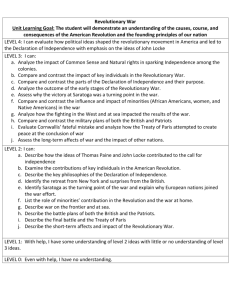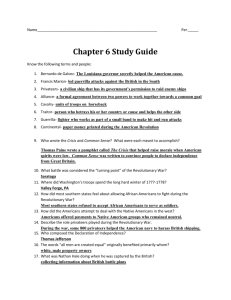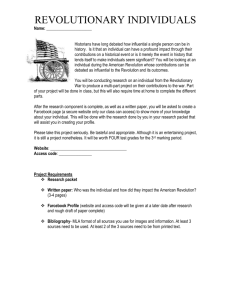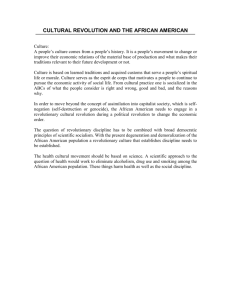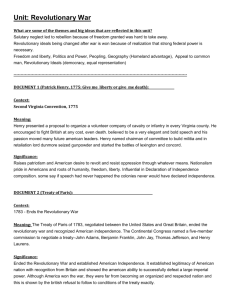Chapter 6 A People in Revolution
advertisement
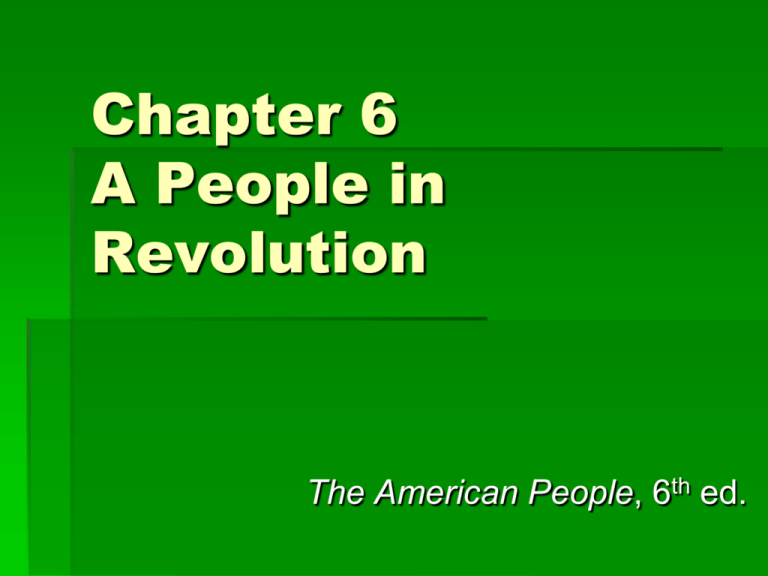
Chapter 6 A People in Revolution The American People, 6th ed. I. Bursting the Colonial Bonds The Final Rupture/Common Sense/Declaring Independence The revolutionary fire was lit with the occupation of Boston in 1775 by 4,000 British troops. Redcoats were tasked with rounding up revolutionary leaders and seizing the arms depot in nearby Concord. Military skirmishes ensued prompting the second Continental Congress to create a standing army in defiance of England. In 1775, the king sent 20,000 additional troops to the colonies to suppress the insurrection. Revolutionary leaders understood there was no going back. Thomas Paine’s pamphlet Common Sense described the outrages of the English government in plain language that inflamed the masses. A congressional committee chaired by Thomas Jefferson produced the Declaration of Independence and distributed it to the world on July 4, 1776. II. The War for American Independence The War in the North and South The British established their military headquarters in New York City. Washington’s troops repeatedly tried to assault the British to no avail; few American victories in the war’s first years. The South proved no match for superior British forces as Savannah and Charleston fell quickly. Eventual entry of France as an ally of America turned the tide against the British. The Articles of Confederation A congressional attempt to create a more stable and lasting central government. Bitter disputes in Congress left the Articles with little power. States remained in charge of their own destinies and Congress could only rely on the generosity of the states for finances. Compromises regarding western claims of territory finally led to approval of the Articles in 1781. Native Americans in the Revolution Intertwined with the fate of the colonists since first contact, the Indians could not help but be drawn into the war. Continued encroachment by white settlers into the western lands of the Indians caused resentment and violence. The neutrality of the powerful Iroquois nation quickly dissolved as the war began. Allied with the British, the tribe terrorized much of New England throughout the conflict. Negotiating Peace The Treaty of Paris, signed at Versailles in 1783, acknowledged the independence of America and recognized the country’s western border at the Mississippi River. Crucial to victory in the war was the indomitable will of the American people, the effectiveness of the state militias, the French fleet, Washington’s military expertise, and a series of inept blunders on the part of a larger and better equipped British army. III. The Experience of War Recruiting an Army As many as 250,000 men may have borne arms in the Revolutionary War. Early enthusiasm for the war transformed into a “poor man’s fight” with paid substitutes and criminals shouldering much of the burden. Pay was slow and some troops openly revolted as supplies dwindled. Civilians and the War Devastation in the lives of city dwellers was profound. Fire and vandalism destroyed much of the existing structures in the larger cities. Refugee traffic increased throughout the war as civilians struggled to escape the ravages of the armies. Smallpox killed some 130,000 people while only 25,000 American soldiers died as a result of fighting. The Loyalists Many colonists who had remained loyal to the Crown emigrated to Canada, England or the Caribbean. Tens of thousands of colonists evacuated with the British troops from New York after the surrender. Public punishing of Loyalists—when found—came to be politically popular. African Americans and the War Thousands of African Americans participated in the Revolutionary War, both free and slave. Many slaves began to question their own oppression after hearing the colonial rhetoric regarding freedom. Many blacks sought freedom behind the English lines, and many Southern blacks fled North. IV. The Ferment of Revolutionary Politics Mobilizing the People During the Revolution, politics caught peoples fascination and became a standard sermon topic for the clergy. Most believed revolution was a mandate from God. The average Americans were determined to incorporate the ideals of independence into their own lives. A Republican Ideology Basic to Republican belief is a rejection of the concept of monarchy. Oversight of government by the people is the only true method of achieving liberty. Historically, trouble arises from too much government. Responsibility for political order should rest with the people. Forming New Governments A few states retained their original charters with only minor changes. Most states adapted new constitutions in order to provide a written documentation of rights and responsibilities. Massachusetts set the pattern for constitution-building in 1779. Women and the Limits of Republican Citizenship Men of the Revolutionary period were agreed that women should be excluded from public affairs. Republican virtue was thought to embody primarily masculine traits such as rationality, self-discipline, and public sacrifice.

